Burton T. (et. al.) Wind energy Handbook
Подождите немного. Документ загружается.

was, of course, at the expense of significant negative phase sequence currents
flowing in the generators and associated heating and losses, although in this wind
farm nuisance tripping was not reported. The wind farm slightly reduced the
voltage flicker measured at the point of connection using a flickermeter. This was a
complex effect with the generators raising the short-circuit level but also introdu-
cing fluctuations in current. There was a slight increase in total harmonic voltage
distortion with the wind farm in operation, mainly caused by a rise in the fifth and
seventh harmonics when the low-speed, high-impedance winding of each generator
was in service. This increase was probably associated with a parallel resonance of
the high-impedance winding of the generators and the power factor correction
capacitors and the high levels of ambient harmonics on the utility network. The
most significant transient event was the energization of the entire wind farm
including 24 turbine transformers, but without the wind turbine s connected. This
led to a transient 8 percent dip on the 33 kV voltage. Energization of the wind farm
in this manner is rare and occurs only after disconnection by the grid interface
protection.
Davidson identified three main sources of power fluctuation: wind turbulence,
blade passing, and blade pitching. The major effects were found to be at wind
speeds of 9–10 m=s, mainly due to wind turbulence, and above 20 m=s due to
blade-pitching effects, although the pitch control on these turbines was not com-
pletely effective in high wind speeds. The highest wind speeds (. 20 m=s) led to
the greatest flicker. As might be expected siting turbines in turbulent locations
significantly increased power fluctuations. Individual wind turbine starts/stops
and speed changes made little impact on network voltage flicker.
These results are typical of the experience of connecting wind farms, with a large
number of relatively small induction generators, on to rural distribution circuits. In
a number of studies some aspects of power quality have been shown to be
improved by the effective increase in short-circuit level. However, the effect of
embedded generation plant on distribution network will vary according to circum-
stances and each project must be evaluated individually. In particular, the connec-
tion of large single generators, as opposed to a group of smaller generators, may be
constrained by consideration of flicker.
Craig (1995) undertook a similar investigation on another WEG MS3-300 wind
turbine connected to an 11 kV network in Northern Ireland over a 2 month period.
A particular feature of this study was the very low network short-circuit level
which varied between 8–15 MVA on the 11 kV point of connection depending on
how the 11 kV utility circuits were arranged. The X=R ratio of the source imped-
ance was approximately 0.5 illustrating the highly resistive nature of the long 11 kV
overhead circuits. The site had a mean wind speed of 9 m=s and a turbulence
intensity of 12.5 percent. Measurements were taken to investigate the voltage
disturbances due to wind turbine starts (with and without an anti-parallel thyristor
soft-start), steady-state voltage variations, dynamic voltage variations and flicker
and also volta ge unbalance.
The conclusions of the study were that, under certain circumstances (particularly
high wind speed cut-out and connection without the soft-start) the dynamic voltage
variations excee ded recommended limits. Steady-state voltage variations could be
predicted reliably from load-flow calculations and were within limits. The wind
POWER QUALITY 585
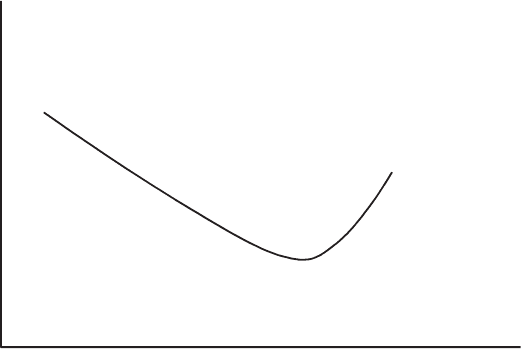
turbine made some contribution to voltage flicker but this was masked during
working hours by a local quarry which used stone-cutting machinery that created
flicker well in excess of the recommended levels. The background voltage unba-
lance on the network exceeded 1.5 percent at times and this was reduced when the
turbine was conn ected and drew negative phase sequence (unbalanced) current.
10.5.1 Voltage flicker
Voltage flicker describes dynamic variations in the network voltage which may be
caused either by wind turbines or by varying loads (Bossanyi, Saad-Saoud and
Jenkins, 1998). The origin of the term is the effect of the voltage fluctuations on the
brightness of incandescent lights and the subsequent annoyance to customers
(Mirra, 1988). Human sensitivity to variations of light intensity is frequency
dependent and Figure 10.14 indicates the magnitude of sinusoidal voltage changes
which laboratory tests have shown are likely to be perceptible to observers. It may
be seen that the eye is most sensitive to voltage variations around 10 Hz. The
various national and international standards for flicker on networks are based on
curves of this type. The use of voltage flicker as an indicator of accep table dynamic
voltage variations on the network is rather unusual as the assessment is based on
the experimentally measured effect of changes of incandescent lamps on the human
eye and brain. It is, of course, possible to change incandescent bulbs to other types
of lamp with a different response and the use of flicker as a measure of disturbance
does not consider explicitly the effect of voltage variations on sensitive equipment,
e.g., computers. However, the flicker standards are generally used to characterize
transient voltage variations and are of considerable significance for embedded wind
generation which: (1) often uses relatively large individual items of plant, (2) may
10
1
0.1
100 1000 10000
Voltage changes per min
∆V/V %
Figure 10.14 Influence of Frequency on the Perceptibility of Sinusoidal Voltage Changes
586
ELECTRICAL SYSTEMS

start and stop frequently, and (3) is subject to continuous variations in input power
from a fluctuating energy source.
Flicker is usually evaluated over a 10 min period to give a ‘short-term severity
value’ P
st
. The P
st
value is obtained from a 10 min time series of measured network
voltage using an algorithm based on the nu isance perceived by the human eye in
fluctuating light. This is illustrated in Figure 10.15 wh ich indicates how flicker is
measured. P
st
is linear with respect to the magnitudes of the voltage change but, of
course, includes the frequency dependency indicated in Figure 10.14. Twelve P
st
values may then be combined usin g a root of the sum of the cubes calculation to
give a ‘long-term severity value’ P
lt
over a 2 h period (Electricity Association, 1989)
although IEC 614000-21 makes no distinction between P
st
and P
lt
limits (IEC,
2000b).
If a number of wind turbines are subject to uncorrelated variations in torque then
their power outputs and effect on network flicker will reduce as
˜P
P
¼
1
ffiffiffiffi
n
p
˜ p
p
where n is the number of generators, P and p are the rated power of the wind farm
and wind turbine respectively and ˜ P and ˜ p are the magnitude of their power
fluctuation.
There is some evidence (Santjer and Gerdes, 1994) that on some sites wind
turbines can fall into synchronized operation and in this case the voltage variations
become cumulative and so increase the flicker in a linear manner. The cause of this
synchronous operation is not completely clear but it is thought to be due to
interactions on the electrical system caused by variations in network voltage.
However, experience on most UK sites, where the winds are rather turbulent, has
been that any synchronized operation lasts only a short while before being
disrupted by wind- speed changes. This may not be the case offshore when the
turbulence of the wind is likely to be lower.
A range of permissible limits for flicker on distribution networks is given in
national and international standards. Engineering Recommendation P28 (Electricity
Association, 1989) specifies an absolute maximum value of P
st
on a network, from
all sources, to be 1.0 with a 2 h P
lt
value of 0.6. However, extreme caution is advised
if these limits are approached as the risk of comp laints increases at between the
sixth and eighth power of the change in voltage magnitude once the limits are
reached and the approximate assessment method proposed in the same document
is based on P
st
not exceedin g 0.5. British Standard (1995), which specifically
excludes embedded generation from its scope, is significantly less stringent specify-
ing that over a 1 week period P
lt
must be less than 1 for 95 percent of the time.
Gardner (1996) describes P
st
limits from a number of utilities in the range 0.25–0.5.
V
Input voltage
processing
Lamp model Eye model Brain model
Statistical
evaluation
P
st
and P
lt
Figure 10.15 Principle of Flicker Measurement
POWER QUALITY 587
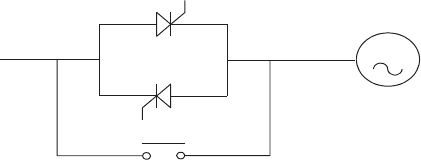
10.5.2 Harmonics
Only variable-speed wind turbines inject significant harmonic currents into the
network. Fixed-speed wind turbines, particularly those with power-factor correc-
tion capacitors, alter the harmonic impedance of the distribution network and, in
some circumstance, create resonan t circuits. This may be important if fixed- and
variable-speed wind turbines are installed in the sa me wind farm. It is noted in IEC
(2000b) that harmonic currents have been reported from a few installations of fixed-
speed, induction-generator wind turbines but there is no known instance of cus-
tomer annoyance or equipment damage due to harmonic currents from fixed-speed
wind turbines.
Thyristor soft starts (Figure 10.16) are commonly used to connect the induction
generators used on fixed-speed wind turbines. Their mode of operation is initially
for the thyristors to be fired late in the voltage cycle and then the firing angle
advanced (over several seconds) until the entire voltage wave is applied to the
generator. Thus the netw ork voltage is applied gradually to the generator and the
current drawn by the generators controlled to reduce any voltage variations on
the network. When operating, these devices produce varying harmonics as the
firing angle of the thyristors is altered. Generally the soft-start units are only used
for a few seconds during the connection of the induction generator and for this
short period the effect of the harmonics is considered to be harmless and may be
ignored (IEC, 2000b). If the anti-parallel thyristors are not by-passed, but left in
service, then their harmonic currents need to be assessed. This continuous use of
the soft-start unit has been proposed in order to reduce the applied voltage and
hence the iron losses in the induction generator at times of low generator output.
However, as well as the complication of trying to deal with harmonics which
change with the thyristor firing angle there are also potential difficulties with the
variation of the applied voltage to the generator altering the dynamic characteristics
of the drive train.
Modern variable-speed wind turbines use network side voltage source conver-
ters, normally based on the Graetz bridge topology (Figure 10.17). These use
insulated gate bipolar transistors (IGBTs) switching at several kHz to synthesize a
sine wave and so eliminate the lower order (e.g., , 19th) harmo nics. The switching
techniques used can vary from rather simple carrier modulated techniques which
compare a reference signal with a trigger signal to those based on space-vector
Soft-start unit
G
By-pass contactor
Figure 10.16 Soft-start Unit for an Induction Generator (One-phase only shown)
588
ELECTRICAL SYSTEMS

theory with some form of two-axis transformation (Jones and Smith, 1993). The
rapid switching gives a large reduction in low-order harmonic currents compared
to the classical line commutated converter but the output current will have signifi-
cant energy at around the switching frequency of the devices (i.e., in the 2–6 kHz
region). Although these high-frequency currents are relatively easy to filter they
may influence the selection of the size of the coupling reactance X
c
which can be
used to form part of the filter to block harmonic cu rrents around the switching
frequency.
10.5.3. Measurement and assessment of power quality characteristics
of grid connected wind turbines
Determination of the power quality of wind turbines and prediction of their
performance in service is not straightforward and IEC 614200-21 (IEC, 2000b) has
been written to provide guidance. There are a number of difficulties when assessi ng
the power quality of wind turbines as their performance will depend on:
• the design of the entire wind turbine (including the aerodynamic rotor and
control system),
• the conditions of the electri cal network to which it is connected, and
• the wind conditions in which it operates.
For example, simple measurement of voltage variations at the terminals of a test
turbine is not satisfactory as ambient levels of flicker in the electrical network and
the X=R ratio of the source impedance at the test site will obviously have a great
impact on the outcome. Hence, for evaluating flicker, a procedure is proposed
where current measurements are made of the output of a test turbine and used to
synthesize the voltage variations which would be caused on distribution networks
with defined short-circuit levels and X=R ratios of their source impedance. This is
illustrated in Figure 10.18 and is referred to in the Standard as simulation using a
‘fictitious grid’. These voltage variation’ s a re then passed through a flicker algo-
rithm to calculate the flicker which the test turbine would cause on the defined
networks. When the installation of the particular turbine is considered at a point on
the real distribution network these test results are then scaled to reflect the actual
Input power from generator
X
c
Figure 10.17 Six-pulse Two-level IGBT Voltage Source Converter (Graetz Bridge)
POWER QUALITY 589
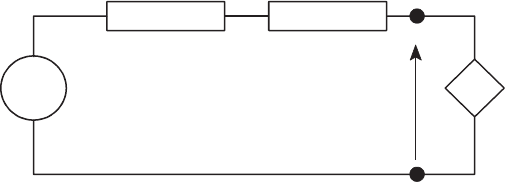
short-circuit level and interpolated for the X=R ratio of the point of connection. A
weighting factor, based on an assumed Raleigh distribution of wind spee d, is also
applied to provide flicker coefficients which may be used on sites with various
average annual mean wind speeds.
The Standard also defines methods to evaluate the impact of wind turbine start-
up at cut-in and rated wind speeds and during speed changing of two speed
generators. Again currents are measured, combined with the ‘fictitious grid’ to
provide a voltage time series and then passed through a flicker algorithm. For
variable-speed wind turbines, harmonic currents are measured over 10 min obser-
vation periods.
10.6 Electrical Protection
All parts of a high-voltage power system are protected by relays which detect
abnormal conditions and circuit breakers which then open to isolate the faulty
circuits. Some lower-voltage circuits are protected by fuses, as these are cheaper but
do not give the degree of control offered by relays and circuit breakers. However,
fuses do have the advantage of operating very rapidly and so limiting the energy
transferred into the fault. On a distribution network the protection syst em is
designed primarily to detect excess currents caused by insulation failure in the
circuits. Failure of insulation, e.g., breakdown of air or of solid insulation, leads to
excess currents either between phases or between phases and gro und. These high
currents are only allowed to persist for up to about 1 s or so in order to limit the
hazards which include: (1) risk to life caused by excess voltages as the high currents
flow into the ground impedance, (2) risk to plant cau sed by the destructive heating
and electromagnetic effects of the high currents, and (3) risk to the stability of the
power system.
The electrical protection of wind turbines and wind farms follows the same
general principles which are applied to any electrical plant (ALSTOM, 1987) but
there are two significant differences. Because wind farms are frequently connected
to the periphery of the power syst em it is common to find that the fault currents
U
RjX
VI
Figure 10.18 Use of ‘Fictitious Grid’ to Establish Voltage Variations for Various Potential
Networks (I – measured current (complex quantity), R – resistance of fictitious grid, jX –
inductive reactance of fictitious grid, U – ideal source voltage, V – synthesized voltage jVj
passed through flicker algorithm)
590
ELECTRICAL SYSTEMS

which will flow in the event of insulation failure are rather small. Although this is
desirable from the point of view of reducing hazards, this lack of current can pose
significant difficulties for the rapid and reliable detection of faults. In particular,
some designs of high-voltage fuses rely on the energy within the arc for their correct
operation. Hence they cannot be relied on to interrupt small fault currents when the
arc energy is low. Secondly, fixed-speed wind turbines use induction machines and
variable-speed wind turbines are interfaced to the network through voltage source
converters. Neither induction generators or voltage source converters are a reliable
source of fault current and so voltage or frequency-sensing relays are needed to
detect abnormal conditions which are fed from wind turbine gen erators.
Figure 10.19 shows the current of an induction generator with a three-phase fault
applied to its terminals. It may be seen that the fault current dies away rapidly as
the stored magnetic energy in the electrical machine decays. There is no sustained
fault current as an induction generator draws its magnetizing current from the
network or local capacitors and this is not possible with the voltage collapsed by a
three-phase fault at the terminals. Some asymmetrical faults (e.g., two-phase faul ts)
can lead to sustained fault currents of two to three times that of full output (Jensen,
1990) but again these are not usually relied on to operate protective relays. How-
ever, it may be necessary to ensure that fault current supplied by wind turbines
does not lead to mal-operation of relays on the distribution syst em by altering the
flow of fault current in the network and, in effect, providing local support of the
network voltage.
The protection of a wind farm has many similarities to the protection of a large
industrial load equipped with machine drives which may back-feed into the
network. This is a useful analogy, for the purposes of protection, as a wind farm
can be thought of as a collection of large electrical machine drives with torque
1.5
1
0.5
0
⫺0.5
⫺1
⫺1.5
200 400 600
ms
kA
Figure 10.19 Fault Current of Induction Generator with a Three-phase Fault Applied to
Terminals (Phase Shown with Minimum DC Offset)
ELECTRICAL PROTECTION 591
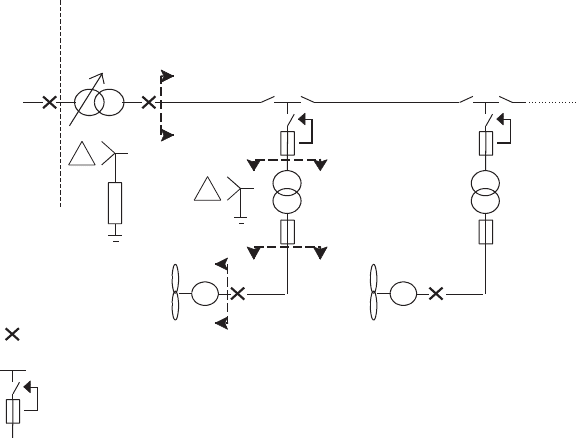
applied to the machine shafts rather than taken to drive mechanical loads. As in the
case of industrial machine drives, the terminal voltages and frequency of the
electrical machines are determined by conditions on the network. The distribution
network provides a reliable source of fault-current which can be used to detect
insulation failure while there is also the possibility of a fault-current contribution
from the rotating machines. In addition, on a wind farm there is also the hazard of
prolonged generation with abnormal frequency or voltage when the wind farm is
disconnected from the rest of the power system. This is known as islanding and is
an important co nsideration for all embedded generation schemes.
10.6.1 Wind farm and generator protection
Figure 10.20 shows a typical protection arrangement for a wind farm of fixed-speed
wind turbines with generator voltages of 690 V and with a collection circuit voltage
of 11 kV. The 11 kV circuit is fed from a 33=11 kV De lta/Star wound transformer
with the 11 kV neutral grounded either directly or through a resistor. The
11=0:69 kV transformers are also wound Delta/Star and so the 690 V neutral points
of each circuit may be directly grounded. The neutral point of the generators is not
connected to ground.
There are a number of zones of protection. At the base of the wind turbine tower
a 690 V circuit breaker (usually a moulded case type as shown in Figure 10.1) will
be fitted to protect the pendant cables and the generator. This is shown as Zone D.
Zone C in Figure 10.20 is the 690 V cables running from the turbine transformer
to the tower-base cabinet. Fuses or another moulded case circuit breaker may be
Utility Wind farm
Main substation
Zone A
33/11 kV
11 kV RMU
Zone B
Zone C
Zone D
Circuit breaker
11 kV switch fuse
A
A
11 kV/690V
Figure 10.20 Protection of a Wind Farm with an 11 kV Connection Circuit (RMU – Ring
Main Unit)
592
ELECTRICAL SYSTEMS
fitted to the 690 V side of the turbine transformer to provide protection of the cables
and also a point of isolation so that all the electrical circuits of the turbine may be
isolated without switching at 11 kV. In some designs of wind turbine, the main
incoming busbar at the bottom of the electrical cabinet at the tower base consists of
exposed conductor. The electrical protection of this area needs careful consideration
as there is the possibility of dropping tools or other equipment on to these busbars.
Zone B is the 11 kV=690 V transformer including the region around its 690 V
terminals. This is a particularly difficult zone to protect as the 11 kV fuses must be
robust enough to withstand the magnetizing inrush current of the transformer
while sensitive enough to detect faults on the 690 V terminals when the fault current
will be limited by the impedance of the transformer. This problem is common to all
11 kV=400 V transformers used on the public distribution network and a typical UK
solution is to use an 11 kV combination fuse-disconnect (sometimes known as a
switch-fuse). Faults on the 11 kV winding of the transformer will lead to high fault
currents which are cleared by the 11 kV fuse. However, for faults on the low-voltage
terminals, the fuse is unable to clear these low fault currents effectively and so, once
the fuse operates, a striker pin operates a mechanism to open the disconnect switch
to clear all the phase s. A more expensive solution adopted on some industrial
installations is to use so-called restricted earth fault protection to detect currents
leaking to ground from the low-voltage winding and terminal area but this requires
an 11 kV circuit breaker. There is obvious commercial pressure to reduce the costs
of transformer protection on a wind farm as there is a transformer for each wind
turbine. However, safety considerations require that all credible faults can be
detected and cleared.
Zone A is the 11 kV cable ci rcuit and this is protected in the conventional fashio n
by overcurrent and earth fault relays operating an 11 kV circuit breaker. The
33=11 kV transformer is protected in a similar manner to a transformer of the same
rating used on the public distribution system.
As wind-turbine ratings increase and larger wind farms are constructed, 11 kV
circuits cease to be cost-effective and so a number of large wind farms have been
constructed with a collection voltage of 33 kV. Figure 10.21 shows a typical
arrangement where a 33 kV wind farm is connected directly to a 33 kV public utility
network. This arrangement poses a number of additional difficulties for the
electrical protection. 33 kV switch fuses are not readily available and so it can be
difficult to provide comprehensive protection of the 33 kV=690 V transform er for
the full range of prospective fault currents. Effective protection for a single phase to
ground fault on the low-voltage terminals is particularly difficult. One attempt to
overcome these difficulties is to use a source protection relay to detect all faults on
the 33 kV circuit, transformer and low-voltage terminals (Haslam, Cross ley and
Jenkins, 1999). Although a suitable technique has been shown to be technically
successful this type of relay is not in production as the commercial demand for it is
too low.
In the arrangement of Figure 10.20 the 33=11 kV transformer provides two useful
features when considering electrical protection. Its impedance allows easier grading
of overcurrent relays and, as it blocks the passage of zero-sequence current, fast
acting earth fault relays can be applied to the wind-farm circuit. With direct
connection to the utility circuit these desirable features are not available and, in
ELECTRICAL PROTECTION 593
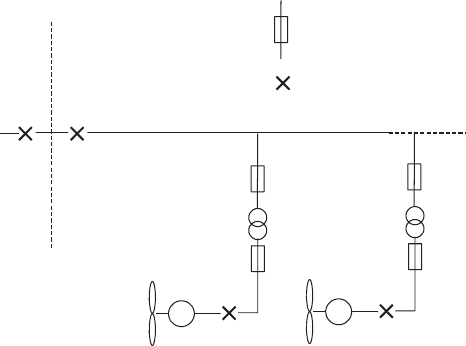
some countries, all embedded generation schemes are required to install an inter-
face transformer even if its voltage ratio is 1:1. This is not an economic solution but
does illustrate the difficulty of connecting a wind farm without a main transformer.
Electrical protection of wind farms follows conventional distribution engineering
practice with the network as the main source of fault current. In the protection of a
public supply network it is important only to isolate the faulty section or circuit and
so maintain supply to as many customers as possible. This discrimination of the
protection is less important in a wind farm as only some loss of generation will
occur if correct discrimination is not achieved and so simpler and lower cost
protection may be appropriate. The difficulty re mains, however, of ensuring that
effective protection is installed to detect all credible fault conditions even with
limited prospective fault currents.
10.6.2 Islanding and self-excitation of induction generators
Fixed-speed wind turbines use induction generators to provide damping in the
drive train and, as there is no direct access to the field of an induction generator, the
magnetizing current drawn from the stator leads to a requirement for reactive
power. In order to reduce the reactive power supp lied from the network it is
conventional to fit fixed-sp eed wind turbines with local power factor correcti on
(PFC) capacitors. As long as the induction machine is connected to a distribution
network its terminal voltage is fixed and so the PFC capacitors merely reduce the
reactive power drawn from the network. However, once the induction generator is
isolated from the network then there is the possibility of a resonant condition,
known as self-excitation, leading to large over-voltages (Allan, 1959, Hindmarsh,
1970). When the generator is isolated from the network it will tend to accelerate as
its load is removed. This increase in rotational speed, and consequently of
frequency, adds to the possibility of self-excitation. There have been a number of
Utility Wind farm
fuse
circuit breaker
Main substation
33/0.69 kV
A
A
Figure 10.21 Protection of a Wind Farm with a 33 kV Connection Circuit
594
ELECTRICAL SYSTEMS
